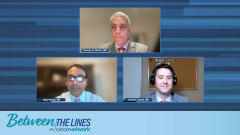
Relapsed/Refractory Multiple Myeloma: Incidence of CRS in MajesTEC-1
Focused discussion on the advent of cytokine release syndrome in MajesTEC-1 and how it compared to the benefits derived from teclistamab therapy.
Episodes in this series

Transcript:
Thomas G. Martin, MD: Let’s talk about our journal article. Let’s talk about the MajesTEC-1 study and our publication on CRS [cytokine release syndrome]. MajesTEC-1 was an open-label, dose-escalation expansion phase 1/2 study evaluating the efficacy and safety of teclistamab monotherapy in patients with relapsed/refractory multiple myeloma. The key eligibility criterion is the patients had received 3or more prior lines of therapy and were triple-class exposed. The big 3 are proteasome inhibitors, immunomodulatory imide drugs, and CD38 antibodies. In this study, they couldn’t have had prior BCMA therapy. Patients went on to receive teclistamab at step-up doses. There are2step-up doses—a small dose of 0.06 mg/kg and another 5times higher of 0.3 mg/kg—given at least 48 hours apart. The first full dose is 1.5 mg/kg and given weekly ongoing. The primary endpoint of this study was overall response rate. There were a number of key secondary endpoints, including duration or response achievement of MRD [minimal residual disease] negativity, PFS [progression-free survival], and then OS [overall survival]. There are also some exploratory endpoints, including looking at soluble BCMA concentration, cytokine levels, and measures of T-cell activation. Ajay, take us through the incidence and management of CRS with teclistamab as presented on this slide.
Ajay Nooka, MD: MajesTEC-1 [looked at] the incidence and management of CRS with teclistamab. The objective was to evaluate the overall incidence of CRS, the grade of the CRS, the timing of the CRS events, and CRS management. To do this, the management of the CRS was conducted in occurrence with the study protocol. Prior to receiving step-up dosing, patients were premedicated with dexamethasone, acetaminophen, and diphenhydramine during the step-up dosing. Between each dose—step-up dose 1, step-up dose 2, and the target dosing—patients are hospitalized for 48 hours. The dose could be given between 2 and 4days. Before the teclistamab step-up dosing, following the dose interruption, the CRS and fever were completely resolved with no evidence of wider bacterial or fungal infection. In the methods, descriptive statistics were conducted to detail the CRS events observed. These are graded according to the ASTCT [American Society for Transplantation and Cellular Therapy] guidelines.
Thomas G. Martin, MD: Here are some data on the incidence of CRS. Jeremy, take us through this slide.
Jeremy Larsen, MD: When we look at the overall incidence of CRS, about 72.1% of patients will have some grade of CRS. This slide and these data are really helpful to categorize the flavor and intensity of this. Highlighted in the far right column is the first CRS event, and overall patients is the column to the left. About half of patients will have a grade 1 CRS event at some point, which is generally manifested by first fever. Another 21.2% will have a grade 2 event at some point. One of the key takeaways is that grades 3 and 4 are very infrequent: 1 patient with grade 3, and 0 with grade 4 or grade 5. As we think about access to this agent and potentially this type of therapy moving outside CAR T centers, this is reassuring in terms of safety.
If we move down a little further, this is helpful ifwe think about when this actually happens. The median time to onset is 2days. With step-up dose 1, 43.6% of the patients will have some form of CRS; with step-up 2, it’s another 35%. So the bulk of patients will receive that during those priming doses. Another 24% of patients, even with a first full treatment dose, will have a CRS onset at that point. It’s a little unpredictable. That’s 1 of the things that has been a little different compared with CAR T. You can almost predict the onset of this. During those first 3 doses—the 2 step-ups and the first full treatment—there’s a realistic probability that we’ll see a fever at point. As we get later in the first cycle, the patient we assume is in the outpatient setting. They’re receiving their full treatment dose.
If we skip to the right column, with the first CRS event, this is looking at a patient in the outpatient setting: 1% at day 8, 0%, day 15, 1% at day 22. What does that mean? What you’re seeing is CRS during those initial priming doses. Later in the cycle, it’s not that it’s impossible, but it’s very uncommon. In those first 2 weeks you’re wrestling with CRS mostly. One of the key things is that this isn’t something that smolders for weeks in general. These have a median duration of a couple of days and are reversible. This isn’t a manifestation resulting in patients discontinuing therapy. They’re able to stay on. We’ll talk a little more about intervals between dosing. But there’s some flexibility. In patients with active CRS, most of these events have resolved within 2 to 4 days of redosing.
Thomas G. Martin, MD: In the study, and now it’s the standard practice, it’s easy to park them in the hospital for those first 3 doses. In general, that’s when they’re going to have CRS or fever. It’s nice to watch them closely at that point in time. But they all resolve, and all the patients in the study were able to continue on to their additional doses of teclistamab.
This chart looks at the incidence of CRS over time. I like the bar graphs, where the orange is grade 3. It happened at cycle 1, day 1 for 1 patient. That’s pretty low if only 1 patient needed to go to the intensive care unit. Darker green is the incidence of grade 2, and lighter green is the incidence of grade 1. It’s mostly in the first and second step-up doses and in the first full dose. There’s very little green after that, which is great. On the bottom in light blue is the patients that discontinued over time. Most of that is from progressive disease. Obviously, this isn’t a therapeutic that works 100% of the time. These tough patient populations are going to have some relapses and progressors. That’s the incidence. You can see even in cycle 2, 3, 4, and beyond, there’s very little CRS at that point. Most patients can be managed completely as an outpatient at that period of time.
This is a chart graphic of what we talked about. I won’t point out too much, other than the bottom .Looking at the higher grade, step-up dose No. 1 has the highestgrade 2 CRS, at 14%. Step-up dose 2 is 5%. Obviously, it gets lower over time. This is very manageable. It’s a very manageable adverse effect that doesn’t—we can talk about it later, in terms of what patients you wouldn’t treat—limit administration of this to many patients with multiple myeloma. It’s a disease of older adults.
Transcript edited for clarity.
Newsletter
Stay up to date on recent advances in the multidisciplinary approach to cancer.


















































































